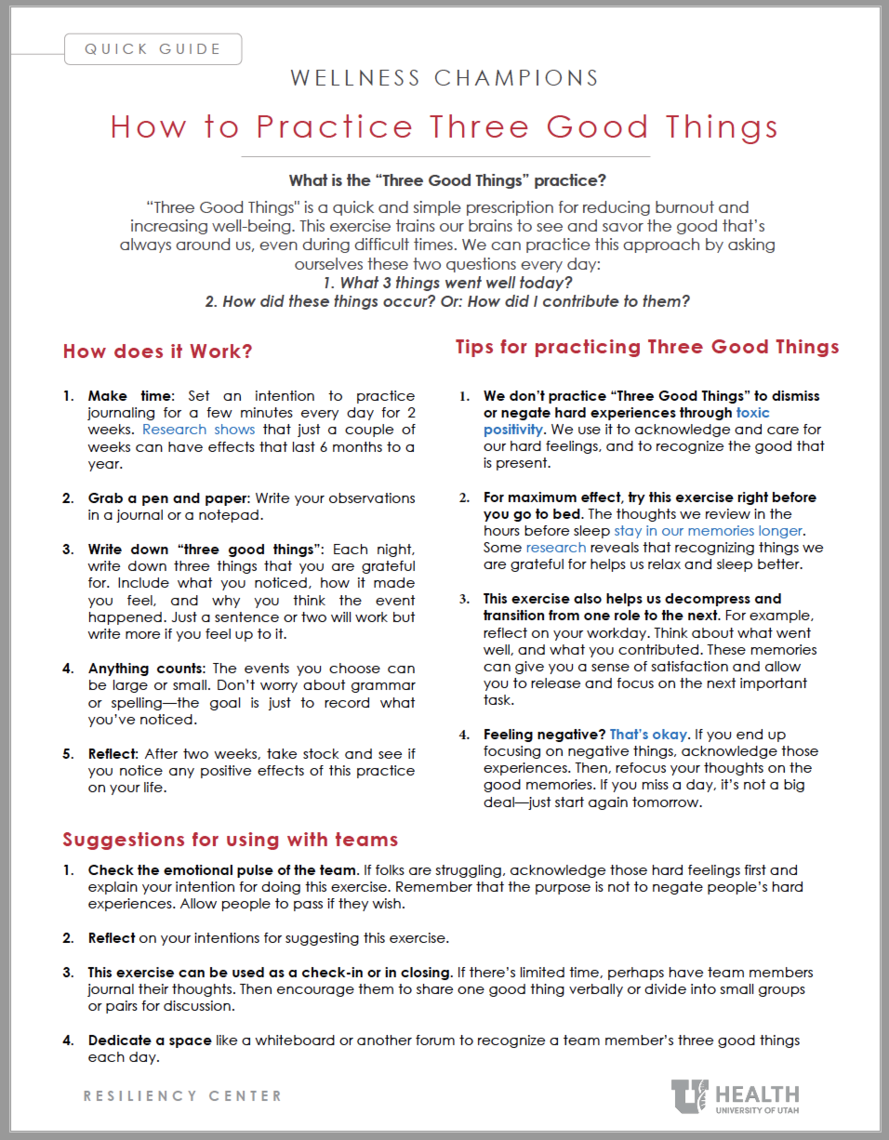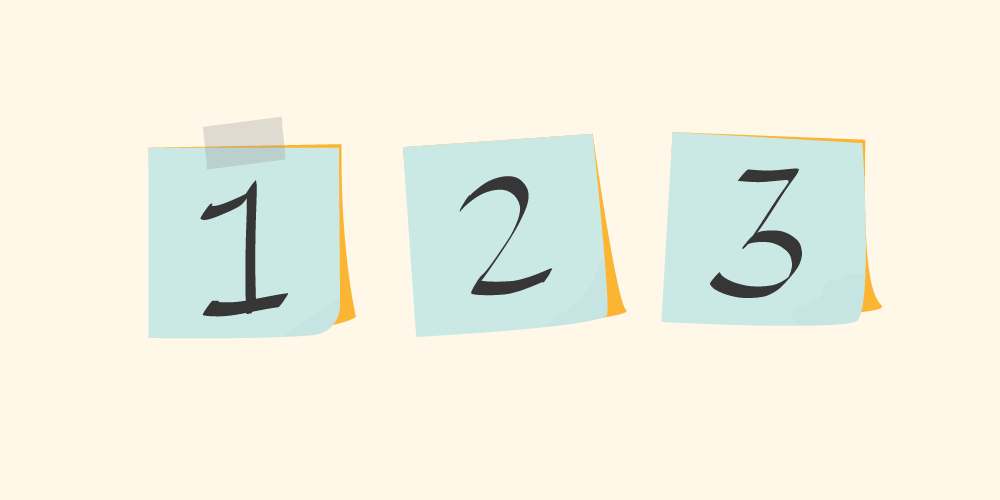Quick Guide

Tools for Teams: Download the "How to Practice Three Good Things" quick guide to use at your next meeting.
What is the “Three Good Things” practice?
hree Good Things is a quick and simple prescription for reducing burnout and increasing well-being. This exercise trains our brains to see and savor the good that’s always around us, even during difficult times. We can practice this approach by asking ourselves these two questions every day:
-
What 3 things went well today?
-
How did these things occur? Or: How did I contribute to them?
Why does it work?
Seeing the full spectrum of life
Life is hard. Feelings like grief, anger, and anxiety play important roles in our lives and serve us best when they are acknowledged and addressed. Taking time to recognize and feel emotions such as gratitude, awe, love, hope, joy, and serenity can benefit us too. These experiences can give us a sense of purpose and meaning, recharge our energy, and improve our relationships.
Randomized clinical research showed that health care providers who practiced “Three Good Things” for two weeks experienced significantly reduced burnout and depressive symptoms, and improved work-life balance and happiness. More importantly, these effects were still present a year later.
Counteracting the "negativity bias"
We have a natural inclination to remember negative events, which is great for our survival, but not for our happiness. When we encounter a negative event our survival instincts kick in. For example, if you’ve managed to survive an encounter in a bear cave, you don’t want to forget that event. You’ve learned a powerful, negatively reinforced lesson: “Avoid bear caves.”
How does this work in the modern world? You might receive ten positive sentiments about your work, and one negative one. Guess which one you’ll most likely remember? The negative one. Psychologists refer to this as negativity bias. We tend to remember negative events and dismiss positive ones. This bias becomes even more prominent when we experience symptoms of burnout.
Practices like the “Three Good Things” counteract the negativity bias. This exercise primes us to look for the good parts of each day. If we know we have to record or tell someone about the positive experiences in our lives, we tend to take in and recognize things that we might otherwise miss. Ready to practice?
“The negative screams at you, but the positive only whispers...”
- Barbara Frederickson, Psychology Professor & Positive Psychology Scholar.
How does it work?
Here’s how to get started:
-
Make time: Set an intention to practice journaling for a few minutes every day for 2 weeks. Research shows that just a couple of weeks can have effects that last 6 months to a year.
-
Grab a pen and paper: Write your observations in a journal or a notepad.
-
Write down “three good things”: Each night, write down three things that you are grateful for. Include what you noticed, how it made you feel, and why you think the event happened. Just a sentence or two will work but write more if you feel up to it.
-
Anything counts: The events you choose can be large or small. Don’t worry about grammar or spelling—the goal is just to record what you’ve noticed.
-
Reflect: After two weeks, take stock and see if you notice any positive effects of this practice on your life.
Tips for practicing Three Good Things
-
We don’t practice “Three Good Things” to dismiss or negate hard experiences through toxic positivity. We use it to acknowledge and care for our hard feelings, and to recognize the good that is present.
-
For maximum effect, try this exercise right before you go to bed. The thoughts we review in the hours before sleep stay in our memories longer. Some research reveals that recognizing things we are grateful for helps us relax and sleep better.
-
This exercise also helps us decompress and transition from one role to the next. For example, reflect on your workday. Think about what went well, and what you contributed. These memories can give you a sense of satisfaction and allow you to release and focus on the next important task.
-
Feeling negative? That’s okay. If you end up focusing on negative things, acknowledge those experiences. Then, refocus your thoughts on the good memories. If you miss a day, it’s not a big deal—just start again tomorrow.
Suggestions for using with teams
-
Check the emotional pulse of the team. If folks are struggling, acknowledge those hard feelings first and explain your intention for doing this exercise. Remember that the purpose is not to negate people’s hard experiences. Allow people to pass if they wish.
-
Reflect on your intentions for suggesting this exercise.
-
This exercise can be used as a check-in or in closing. If there’s limited time, perhaps have team members journal their thoughts. Then encourage them to share one good thing verbally or divide into small groups or pairs for discussion.
-
Dedicate a space like a whiteboard or another forum to recognize a team member’s three good things each day.
Resources
-
Duke webinar – Enhancing Resilience: Three Good Things
-
Duke webinar – Well-being Q+A: Three Good Things
References
-
Sexton JB, Adair KC. Forty-five good things: a prospective pilot study of the Three Good Things well-being intervention in the USA for healthcare worker emotional exhaustion, depression, work–life balance and happiness. BMJ Open 2019;9:e022695. doi: 0.1136/bmjopen-2018-022695
-
Greater Good (UC Berkeley): Greater Good magazine, published by University of California Berkeley, turns scientific research into stories, tips, and tools for a happier life and more compassionate society.
-
Your Skillful Means (Wellspring Institute for Neurosciences and Contemplative Wisdom): Think Google-search for happiness, Your Skillful Means is a database full of wellness insights. Just input a term of choice (we suggest "gratitude practice") and learn all about it.
Trinh Mai
Megan Jean Whitlock
Rob Davies
The Resiliency Center's Jean Whitlock and Megan Call provide a step-by-step guide for infusing frequent and efficient storytelling into your workday.
For the past six years, mindfulness, professional well-being, equity and inclusion expert Trinh Mai has served as a contributor and core member of Accelerate’s editorial team. Now, as she charts a new path, we reflect with profound gratitude on everything she has taught us.
Being new is hard. Often for new faculty, it means adjusting to a new state, new team, new patients, and a new organizational culture. We asked hospitalists Ryan Murphy and Valerie Vaughn and surgeon Ellen Morrow for tips that only come from a little time under the belt.
